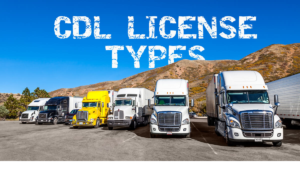
Define Commercial Driver’s License
A commercial driver’s license is a license specific to driving particular types of vehicles such as trucks and buses. This means acquiring one can qualify to drive oversized vehicles and carry loaded items. Some types of CDLs and endorsements are used to transport hazardous materials such as explosives, flammable liquids, and other radioactive substances.
The point here is every truck driver needs to have a CDL. Whether you want to work as a school bus driver, a long-haul trucker, or want to pilot a motorcoach for a rock band, you need to have the right CDL to the job.
In this article, I will give you an overview of how much information you need to know about the classifications and requirements to get a CDL license.
Differences Between CDL Classes
There are three different types of commercial driver’s licenses. These are Class A, B, and C.
Class A CDL
A Class A CDL is the most common CDL class. This permits you to drive any combination of vehicles with GCWR or gross combination weight rating of 26,001 pounds or more. This includes the towed unit with a GCWR of more than 10,000 pounds.
Having Class A CDL can enable you to drive:
- Livestock carriers
- Tractor-trailer buses
- Tractor-trailers and flatbeds
- Tanker vehicles.
- Truck and trailer combinations (double and triple trailers)
Class B CDL
A Class B CDL permits you to drive a vehicle with GCWR of 26,001 lbs or more. For towing purposes, the limit GCWR of the unit should be a maximum of 10,000 pounds.
Having Class B CDL can enable you to drive:
- Box trucks (delivery drivers, couriers, and furniture delivery)
- Dump trucks with small trailers
- Large buses, including city buses and tourist buses
- School buses
- Segmented buses
- Straight trucks
Class C CDL
Lastly, the Class C CDL permits you to drive a single or combination vehicle that is designed to transport a particular number of passengers. This also allows you to drive cars containing materials that may be hazardous or don’t meet other CDL requirements, but with proper endorsements.
Having Class C CDL can enable you to drive:
- Passenger vans
- Small HAZMAT vehicles
- Small truck towing a trailer
This is the first place to start your search.
Submit your information below to find employers and CDL training schools near you.

CDL Endorsements
Aside from knowing the different types of CDL licenses in Class A, B, or C, you may also need to take written and actual tests to qualify on operating particular types of vehicles that your job needs. These tests give you your CDL endorsements in driving specific types of vehicles that are designed for a variety of reasons.
Different types of CDL endorsements include safely towing more than one trailer, transporting dangerous items, and driving a school bus.
For every test and qualification, you are gaining a type of endorsement as a CDL driver.
You may wonder how many CDL endorsements are there.
Obtaining these can vary from state to state. Six endorsements can be put on a CDL. These are:
(T) Double/Triples Endorsement
(H) Hazardous Materials Endorsement (HAZMAT)
(P) Passenger Transport Endorsement
(N) Tank Vehicle Endorsement (Tanker)
(S) School Bus/Passenger Transport Combo Endorsement
(X) Tanker/HAZMAT Combo Endorsement
Requirements to Earn a CDL Endorsement
You should declare the endorsement you want to earn when applying for a commercial learner’s permit or CLP. Some states may limit you to three endorsements with a CLP. Using passing additional test requirements, you can add endorsements to your existing CDL. This will involve written tests or special road skills.
For this, you need to pay a small fee. Then, you need to pass both written and actual exams. Some endorsements don’t need special skills tests, periodic retesting, background checks, and beyond the initial CDL process.
Since there are tighter restrictions for transporting dangerous materials, the HAZMAT or Hazardous Materials endorsement is the only exception.
Type of CDL Endorsements You Should Get
The more endorsements you acquire, the higher your chances to make more money and be more successful in the future. It’s always good to prepare for whatever opportunity you may have in the future. Hence, holding more endorsements make you more appealing to employers. This also gives you the flexibility to shift to a better-paying job when the opportunity comes.
The cost to take an endorsement test is around $20, which is affordable. The cost varies by state and it depends on the endorsement you’re looking for. Once you acquire one, you need to remember to renew the endorsement along with your CDL renewal.
Here are the CDL endorsements available for each CDL Classification
For Class A license, you can hold one or more of these Class A CDL endorsements:
(T) Doubles/Triples
(H) Hazardous Materials (HAZMAT)
(P) Passenger Transport
(S) School Bus/Passenger Transport
(N) Tank Vehicle
(X) Tanker and Hazardous Materials
For the Class B license, you can hold one or more of these Class B CDL endorsements:
(H) Hazardous Materials (HAZMAT)
(P) Passenger Transport
(S) School Bus/Passenger Transport
(N) Tank Vehicle
(X) Tanker and Hazardous Materials
For the Class C license, you must hold one or more of these Class C CDL endorsements:
(H) Hazardous Materials (HAZMAT)
(P) Passenger Transport
(S) School Bus/Passenger Transport
Restrictions of a CDL or Commercial Driver’s License
A driver may prohibit from operating a manual transmission if the skills test was performed on a vehicle with an automatic transmission. Other restrictions of a commercial driver’s license include the following:
B – Corrective lenses
C – Mechanical aid
D – Prosthetic aid
E – Automatic transmission only
F – Dual outside mirror
G – Daylight only operation
K – CDL intrastate only
L – Vehicles without air brakes
M – Group B or Group C passenger vehicles
N – Group C passenger vehicles only
O – No fifth wheel (combination vehicles)
P – Commercial Learner’s Permit Only. No passengers other than trainer, additional trainees or test examiner
U – Hearing aide required
V – Medical variance required
W – Medical waiver required
X – Commercial Learner’s Permit Only. No cargo in tank vehicle and tank must be purged. Restricts “N” endorsement
Z – No full air brake-equipped commercial motor vehicle
Restriction M on CDL
Having a restriction on your CDL means you are limited to which vehicles/equipment you are authorized to drive. For the Class A CDL, M is the restriction. This means you obtained your school bus or passenger endorsement in a Class B vehicle.
When you have the M restriction, this means you can only drive a Class B or Class C school bus or passenger vehicle. While you do have a Class A CDL, you cannot operate any class A passenger vehicle.
For the removal of the restriction, you need to refer to your state’s laws and regulations.

